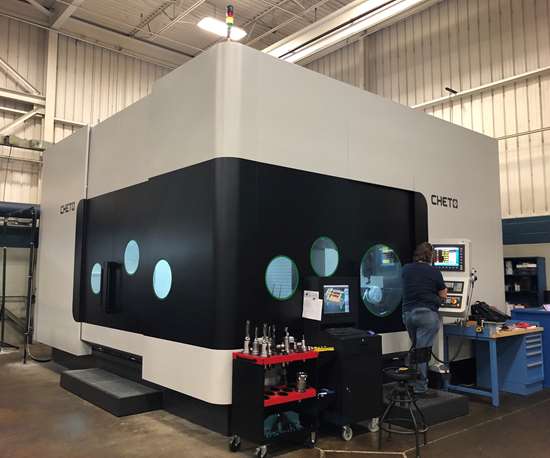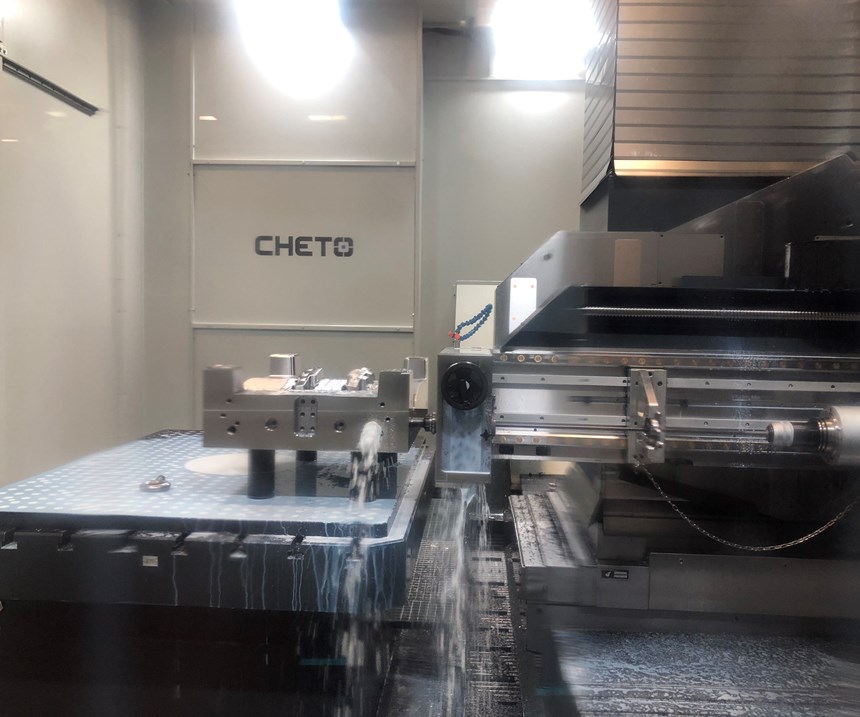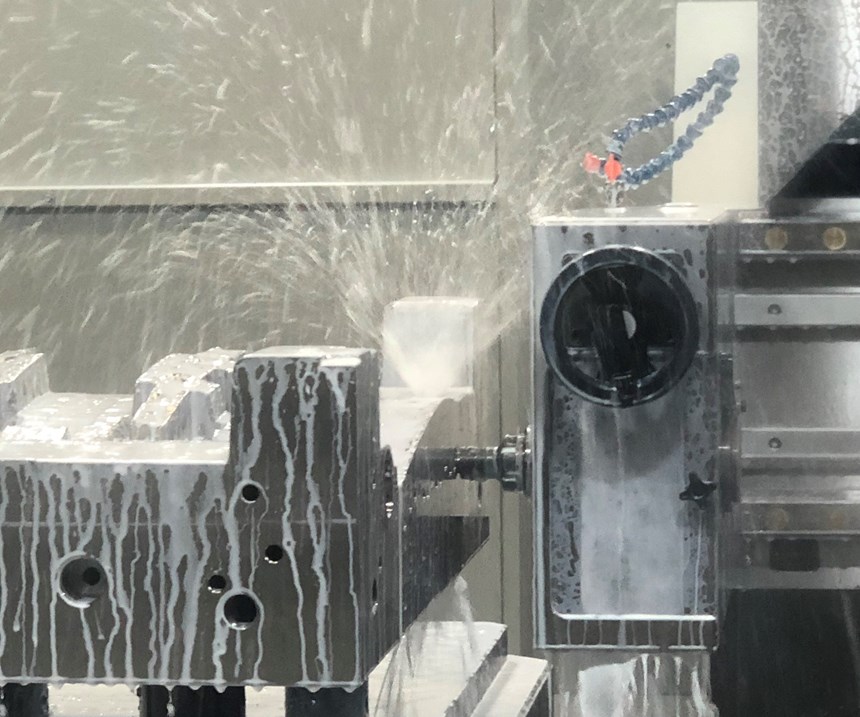CNC Deep-Hole Drilling with Milling Transforms 2D Machining
Appears in Print as: 'CNC Deep-Hole Drilling with Milling Transforms Moldmaker’s 2D Machining Processes'
Midwest Mold Services dramatically reduced costs and lead times with investment in new multitasking CNC machine.
#leadership #drills #hmc
Midwest Mold Services (Midwest Mold) in Roseville, Michigan, used to outsource boring mill and gundrill work to companies that service the overflow from mold builders with more work than they can handle. It became clear over the last two years that with the boom in automotive jobs came elongated lines of shops waiting for that work to be done and returned. Once the work came back, the rush would begin and overtime became standard, as were extended lead times. Because of this, Midwest Mold became the first mold shop in the United States to purchase a CNC machine from Cheto Corp. S.A. (Oliveira de Azeméis, Portugal), an investment that brought the outsourced work in-house and solved multiple challenges, according to Midwest Mold President and CEO John Hill.
Plastics engineers founded Midwest Mold in 1994. They were seeking to provide support to automotive original equipment manufacturers (OEMs) and their Tier 1 custom molders. Hill says, “I came from a large production mold builder, and every time we would get these emergency repairs or engineering changes, it would interrupt the flow of the new tool builds and jeopardize delivery dates. We saw that as an opportunity.” Going down that path was a very good opportunity, he says. However, it became very cyclical in nature—when molds were not breaking, less work was available. Before long, regular customers began asking for new molds, and because Midwest Mold had all the necessary equipment (like the ability to receive and process mold data, CNC machines, programming software and a skilled workforce), the company began building new molds. “The rest is history, as they say,” Hill says. “Today, about 75 percent of our revenue is new tool construction, and then a portion of that is prototypes, repairs and engineering changes to tools that we have built.” In 2006, the company began offering low-volume molding of non-automotive plastic parts in an effort not to compete with its customer base.
Featured Content
Vendor Capacity Dried Out
“For the past 20 years, we've been designing and building high-volume production tools without a gundrill or boring mill on our premises,” Hill says. Midwest Mold began using the consulting services of Harbour Results Inc. (HRI), which forecasted two years ago that automotive OEM demands would exceed the capacity of Tier 1 and 2 mold suppliers. “We were hearing and seeing that happen, and then it was not long before we started feeling it,” he says. “It negatively affected our lead times and our delivery dates, and it was causing us to pay excessive overtime to compensate for services that our sub-suppliers used to be able to provide us in the past.”
We both felt it also could make a sincere impact on the U.S. mold-building community.
Hill says that he began researching various brands of gundrill machines, knowing that his company had to bring that capability in-house as soon as possible. Molds that Midwest Mold builds often run in 2,000-ton and 2,500-ton injection presses. “But, our sweet spot is in the 300- to 750-ton range, and the majority of our machines are set up around that X and Y travel, size-wise,” he says. Purchasing a gundrill that would be large enough to accommodate the molds Midwest Mold was building required Hill to custom-order it and be patient. “It's the same with any of the gundrill manufacturers for machines of that size, whether it's a German manufacturer or U.S or European, the gundrill is a built-to-order machine,” he says. “So, we knew that we would have to get in line and wait our turn. When your machine is done, it is done.”
While he was searching, Hill also contacted Dan Meehan, president of Performance Machinery LLC (Sterling Heights, Michigan), a CNC machine supplier with whom Midwest Mold has built a 20-year relationship. It turned out that Meehan was in negotiations with Cheto Corp. S.A. (Cheto) to be its U.S. distributor. “The timing was perfect,” Hill says.
Meehan explains that he met Carlos Teixeira, Cheto’s CEO, at IMTS 2016 and immediately saw a great potential partner whose technology was just starting to take off in Portugal and Europe. “We both felt it also could make a sincere impact on the U.S. mold-building community,” he says.
Not Your Ordinary CNC
“The more that Dan and I talked, the more I got exposed to Cheto’s equipment and capabilities, which were unlike anything that I had ever seen before,” Hill says. “This machine can do the milling. It can do the deep-hole drilling, and it can do all the 2D work on one machine. The workpiece goes on this machine, and it does not come off until 100 percent of the 2D work is completed.”
The Cheto IXN2000 is a seven-axis machine. The automatic rotary table measures 1,600 millimeters by 1,300 millimeters and the spindle speed is 4,500 rpm. According to Cheto, the all-in-one concept enables moldmakers to perform multiple operations with one setup, including deep-hole drilling, radial drilling, milling, tapping and boring. “It is not simultaneous machining like a five-axis CNC, but the Cheto has seven movements,” Hill says. The pivot point of the head is at the very front of the column, so it can index up and down 25 degrees and 15 degrees, with an option for ± 25 degrees. Additionally, the spindle can travel all the way to the center of the table to reach smaller parts. “The table can rotate any increment of 360 degrees, and then there are the X, Y, Z and W axes. Users can machine all four sides. They can set it up on its side. They can do compound angles. It's just so versatile,” he says. This machine is a game changer because again, it is a 2D machine for the mold building side of mold manufacturing, and it can do it all versus a machine that only does gundrilling or milling.”
Users can machine all four sides. They can set it up on its side. They can do compound angles. It's just so versatile
Meehan says that other unique features of the Cheto include the fact that it is a “floor-mounted” machine, meaning that there is no need to pour deep, expensive foundations. Also, every Cheto has linear glass scales or encoders (or both) on every axis.
Because of his long-term relationship with Meehan, and because Cheto wanted to bring a machine to the United States, Hill says that he knew he would get the support he needed, and it made his decision easy. “I was looking at other machines, but it was because of the multitasking capabilities that I bought the Cheto IXN2000 deep-hole drilling CNC machine sight-unseen,” he says.
Capability and Capacity Count
The 3D contouring machining centers that Midwest Mold owns cannot do what the Cheto can do, but the Cheto can do what the 3D contouring machines can do, Hill says. “I can drill holes with my other CNC machines. I just can't drill deep holes. I can purchase standard, through-coolant spindles and drills for the standard CNC machines but not up to 40 inches in length. They are limited to about 16–18 inches, and a lot of that has to do with the Z height because they are vertical machines that must compensate for the cutter length and for the size of the blocks being machined. To go deeper, we go horizontal, and that is what the Cheto is, a horizontal machine.”
That machine can drill 40 inches in one direction and that is significant.
He says that the Cheto IXN2000’s footprint is about 22 feet by 22 feet. “We basically have a big room built around the table, column and base, and they have to be able to move away from each other, so we have a much longer horizontal machine,” he says. While most boring mills are horizontal for that length and size, Hill says they do not have the unique capabilities of the Cheto. “Had we settled for just a gundrill, we would have only solved one problem here. With the Cheto, we solved multiple problems. That machine can drill 40 inches in one direction and that is significant.”
Gaining Control Over a New System
Midwest Mold has 43 employees, two of whom have received training on the Cheto IXN2000, working in tandem to get full use of the equipment. Hill says it was a very involved process once the machine was delivered from Portugal. For example, he says that the controller on the Cheto is new to Midwest Mold. “We're very used to FANUC controls, Mitsubishi controls and the programming software, but the Cheto uses the Wise Active Control system. It also uses a European control called Fagor CNC 8065 Windows 7, which is not used commonly in the U.S. moldmaking industry. So, our guys are learning new software, learning a new control, learning a new machine and Cheto is training them simultaneously, which has enabled them to get jobs up and running fairly quickly.”
Meehan explains how the patented Wise software increases the Cheto’s machine performance, giving Midwest Mold additional advantages. “The software measures load on both the spindle motor and the drive motor to detect the hardness changes in the block of steel and automatically adjusts the feedrate to facilitate this hardness change,” he says. “This feature also increases the tool life by as much as three to four times the normal length according to Cheto users that we talked to in Portugal.” Meehan adds that the Wise monitoring function also measures the coolant pressure in the cut. “The Cheto uses a water-based coolant instead of oil, which is truly unique.” He says that using coolant combined with the Wise software and the newer technology in drills enables the user to run a safer process with little or no deceleration in cutting speeds. “Using coolant versus oil eliminates any cross-contamination as the block moves through the shop from machine to machine,” he says. “Coolant is cleaner for the operator, and it is contained because we install mist collectors on the Cheto machines.”
Cheto also uses a screw-driven, high-pressure pump which provides more consistent pressure for more stable machining, plus the Wise software can detect holes and cavities as the drill breaks into and out of the steel, which is another unique feature, according to Meehan.
Saving Real Time and Money
When asked to quantify the time that Midwest Mold is now saving with the new Cheto, Hill says that previously, the 2D work was being handled in-house and that the mold halves would then be sent out for gundrilling and boring. Taking into consideration the shipping time plus the time that the work waits to get on a machine at the sub supplier and then the actual machining time, he says it would take anywhere from three to six weeks to get the two mold halves machined and returned. “With the Cheto, we are doing everything in five days or fewer,” he says. “That is real time, and time is money.
With the Cheto, we are doing everything in five days or fewer.
“Cheto understands the machining and the processing,” Hill says. “Cheto knows that for us to be profitable in mold building, we must reduce the amount of direct labor that goes into building a mold. There are so many steps that must happen, but if we can reduce the amount of direct labor, we can improve our profitability. This machine does just that—it reduces the direct labor, it reduces setup time. It's a game changer. I can't say enough about that.”
Since the installation and training on the Cheto in June, Midwest Mold is already seeing a 20-percent reduction in the amount of direct labor on the 2D side of the mold-building process, Hill says. “The 2D is only a portion of the total mold build, but that 20-percent time savings gives us more capacity to do more work without adding more direct labor,” he says. “It also gives us the ability to improve the timeframe in which we get these jobs done. We're always against the clock—that is just the way the trade is, so any hours that we save and any efficiency improvements that we make equals dollars that we save.”
RELATED CONTENT
-
Making Quick and Easy Kaizen Work for Your Shop
Within each person is unlimited creative potential to improve shop operations.
-
Benefits of Automating Employee Performance Management
How to drive high employee performance, increase employee engagement and retention, and ensure your business has the critical skills it needs to remain competitive.
-
Considerations for Mold Base Material Selection
Choosing the right material can greatly affect the profitability and cost of your application.
















